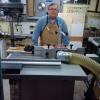I'm getting to the point I want to get serious about setting up my tools
(TS, Band Saw, Jointer, Miter Saw) as close to perfect as realistically
as possible.
What types of gauges will I need to achieve my desired results.
Jigs? Are there any I should be looking in to making?
and lastly (for this post anyways) can you point me in the right direction for good reference material?
Books, videos, DVD sets, etc...





 Reply With Quote
Reply With Quote






